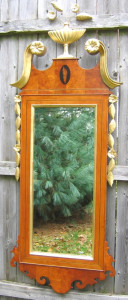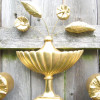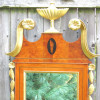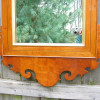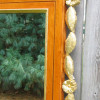- Looking Glasses (Mirrors)
- Looking Glass
Looking Glass
Member Gallery
Address
Contact
Primary woods: Curley cherry, cherry, wenge, (frame, panels & inlays) Secondary woods: Basswood (carvings) Poplar ( back panel)
My latest completed project is a New York Hepplewhite mirror circ 1780-1800 reproduction. I started the mirror last December after completing a chest on frame stopped in the spring and re-started on it this fall. I really don't know the hour total for it but it seemed like I tinkered with it as much as I had with larger furniture projects. The mirror is not an exact duplicate of any one in particular, but rather borrowed elements from a couple different examples I found and my own scroll design.
The top and bottom panels were made by laminating 1/8" thick re-sawn figured cherry to plain cherry boards. The shell inlay was made of figured cherry set in a wenge oval background. The banding was constructed by laminating hard maple on each side of a strip of walnut. This banding was then inset into the cherry frame.
The inside and outside edges of the frame are moldings that were made with scratch stocks, then attached to the main frame. All four corners of the frames were assembled using splines and dowels. The top and bottom panels were attached to the frame using stub tenon's doweled in place to address the cross grain situation.
The gooseneck moldings, urn, decorative flowers and leaves were all hand carved from basswood. The goosenecks and urn were attached to the top panel with glue and dowels. Flower and leaves were assembled and attached to the mirror frame using brass rod.
All carved pieces were sealed with shellac providing a good base before applying a brass /copper composition leaf foil that simulates gold (but a lot less expensive to learn with) then sealed with lacquer.
The frame finish is two coats of garnet shellac to impart a brownish tone, followed up with approximately twenty five coats of padded clear shellac. The finish was allowed to dry and harden for a few days then rubbed down with 4/0 steel wool and a final rub-out with rottenstone.
This was my first attempt at doing a somewhat simplified gilting process as well as hand carving the Goosenecks and other ornaments. After I got started it wasn't that difficult, however I'm sure that after a few more under my belt they will look better.
All in all it was a good project, a bit long, however the tecqniqes I learned I'm sure will come in handy on future projects..
Thanks for looking Greg Brunk...

